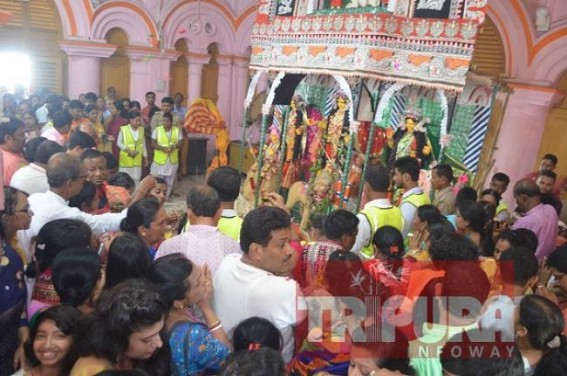TIWN Oct 5, 2019

AGARTALA, Oct 5 (TIWN): Like every year, thousands of devotees rushed to Agartala Durga temple on Saptami to mark auspicious Durga puja on Day-1. Throughout the year, people wait for this Durga puja festival and the enthusiasm amongst people remains as high in Tripura just as Bengal. Since early morning, people have been thronging at Durga Bari temple where idol of the goddess Durga with two hands, offered “Anjali†and her four children are being worshiped. Apart from this ancient Durga temple, 2459 clubs are organizing Durga puja this year along withy houses and temples. There are more Durga temples across Tripura which are ancient with historical significance Durga Puja is over 500 years old tradition in state since Kings' era and is sponsored by the Tripura government now continues to be a draw for devotees.
The capital of the princely dynasty along with royal temple moved three different places - Udaipur, Amarpur and Puran Habeli before the state headquarters and the capital city along with the Durgabari temple settled in Agartala 178 years ago in 1838 by then Maharaja Krishna Kishore Manikya (1830-49).
On yesterday, it was “Shasthi” which is the most important day because Goddess Durga’s face is unveiled on that day and also on “Shasthi” Dei Durga arrives on “Marta-Lok” (earth) to meet her family. On this day Lord Rama’s had worshipped Goddess Durga in order to relief Devi Sita from Ravana’s captivity.
Today is “Saptami” which is believed the actual beginning of Durga puja, also known as Durgotsav.
Know the Significance of Saptami : The seventh day has a legend behind it. Lord Rama was preparing for an epic battle against the ‘King of Demons’, Ravana who had abducted his wife `Sita’. Before starting the war, Rama prayed to Devi Durga for her blessings.
It was a tradition that Goddess Durga had to be worshipped with one hundred `Neelkamal’ (blue lotus flowers) but Lord Rama could arrange only ninety-nine of them. Out of desperation and intense desire to please the goddess, Lord Rama decided to take out one of his blue coloured eyes (resembling blue lotus) and offered it to Goddess Durga. Durga was pleased with Ram’s devotion; she appeared before Ram and blessed him. Lord Rama’s worship of Goddess Durga took place during the autumn month of Ashwin and the battle started on the saptami i.e. the 7th day.
The battle was won by Ram with the blessings of the Goddess of Power.
Rituals
Bathing Navapatrika : The most important significance of Maha Saptami is the bathing ceremony of Navapatrika. Here, the nine plants (banana, pomegranate, turmeric, jayanti, ashoke, bel, arum plant, colacassia and paddy) are tied together and taken to the river Ganges at pre-dawn for bathing. The puja starts after that.
Significance of Nine Plants : To understand the importance of Maha Saptami, you must know the significance of those plants. During the war, Devi Durga created ‘Ashtanayika’ (eight war partners). These eight goddesses and Devi herself symbolize “NavDurga”. The nine plants stand for each impersonation of the Goddess.
Maha Snan : The importance of Maha Saptami can not be described completely without this. Goddess Durga is treated as the dearest daughter. So, a mirror is placed in a way that the reflection of Goddess Durga can be seen in the mirror. This mirror is given the ritualistic bath which is known as Maha Snan.
Prana Pratishtha : A pot filled with holy water is placed before the deity. A bunch of five mango leaves and a coconut is placed on the pot. It is believed that the priest consecrates the Goddess on that pot with divine chants and hymns. Then the goddess is worshipped with sixteen special puja items.
- Protest in Tripura against Tripura Education Board's Huge Fee Hikes
- Patient Party Alleged 'Punishment Referral' Punishment for Speaking Out at IGM Hospital
- Pakistani Woman Held in Sabroom, Probe Underway
- 150 Mobile Phones Recovered in Sonamura Border Operation
- ABVP Demanded Every Year 'Little' fee hikes for TBSE Exams



